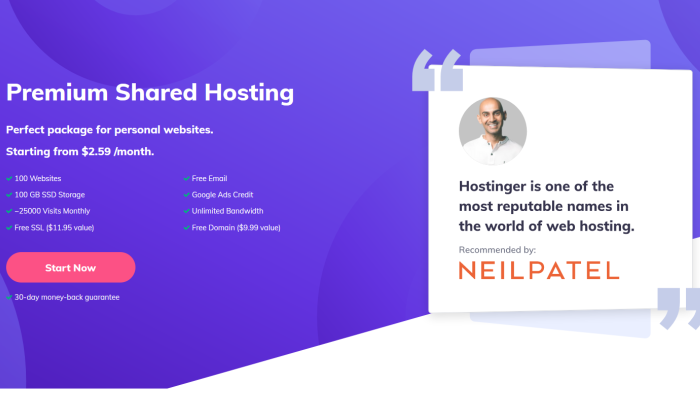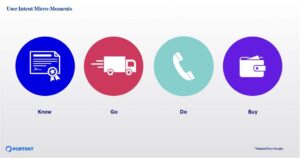Every website has a domain – it’s what makes it unique and it’s where your site lives on the internet. I use neilpatel.com, as you can see in your browser.
So, one of the first steps of building a website is getting that domain to call home.
And that domain is going to cost you money.
That is, unless you keep reading this post.
I’ll walk you through how to get a domain name that aligns with your business and establishes your brand, and how to get it for free.
If this sounds like a foreign language, don’t worry. I’ve made it as simple as possible and will walk you through each and every step to get a free domain name in no time.
Your 2-Minute Cheat Sheet
Want a quick answer on how to get a free domain name? I’ll cut to the chase.
If you’re planning to start a blog or launch a website, you’ll need a web hosting company. When it comes to making a choice from the many available options, I suggest Hostinger.
Not only does the company provide excellent speed and uptime reliability, but it also offers a free domain name for the first year.
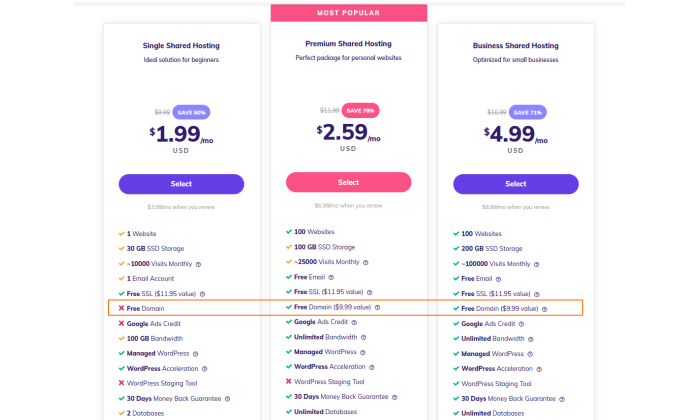
Get your domain and hosting set up in one fell swoop with Hostinger. You still have to pay for hosting (which you can lock in for under $3 per month), but you get the domain name for free.
You can create a Hostinger account and sign up by clicking here. With the easy guided setup, the whole process just takes a couple of minutes.
After that, you’ll have hosting, a domain, and a basic website ready to go.
If your budget is really tight at the moment, you can also consider using a free subdomain.
This is where website builders like WordPress and Wix come into play. The only catch is that, instead of having a simple .com site like mine (NeilPatel.com), you‘ll have something like
yourusername.wixsite.com/yoursiteaddress or yourdomainname.wordpress.com.
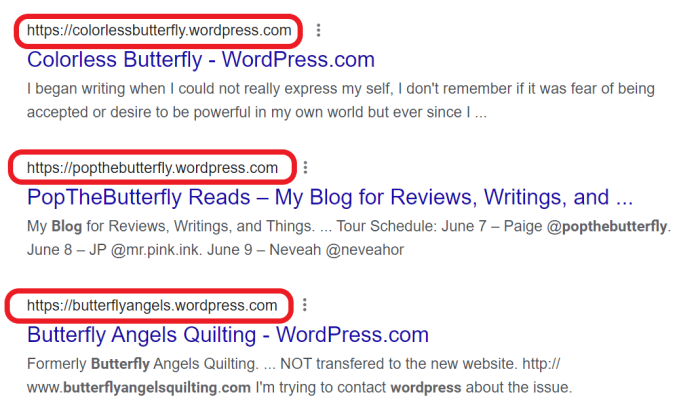
This isn’t an ideal situation. Some downsides of not having a clean .com include:
- Not having a well-branded URL: My URL, neilpatel.com, is synonymous with my brand. All people have to remember is my name, and they can easily find me online. Everything on my site, from my picture and bio to my name in the browser bar, confirms my brand. That builds authority that’s important for connecting with visitors and for SEO. Can you create authority content without a clean .com? Yes, but having your own branded URL starts you out on a better foundation.
- Making it harder for people to find you: What’s easier to remember — coffeemugdesigns.wordpress.com or coffeemugdesigns.com? It’s a small thing, but people have to keep track of a massive amount of information today. Making your URL easier to remember is a small way you can offer a better experience for potential customers and clients. For example, if your coffee mug boutique has a vendor table at a local farmers market and someone browses through on a Saturday morning but doesn’t buy, a clean domain name helps them find you when they want to buy later.
- Reducing trust for site visitors: Taking the step to get your own domain name free of other brands like WordPress demonstrates professionalism and commitment. That helps build trust with your audience and can be especially important if you want people to pay with credit cards or other methods right on your site.
All that said, a free subdomain can be a viable option when you want to experiment with the free features of the website builder. It may also be a temporary way to get your content online so you can start building a website before investing in a clean .com. In many cases, you can convert your site to your own domain and even other hosting solutions at a later date.
If not having a clean .com is a non-starter out of the gate, don’t worry. The process for getting set up with Hostinger and snagging your free domain is as simple as it can be.
Read on to follow the three easy steps to get a free domain name for your website.
- Go to Hostinger’s Website
- Select Your Hosting Type
- Claim Your Free Domain
You’ll be able to do all of this in one place with Hostinger. I will walk through some of your other options, but you may need to interface with multiple vendors to accomplish all of these steps.
Step 1: Go to Hostinger’s Website
The very first thing you need to do is head over to Hostinger by clicking here.
Click Start Now and you’ll be taken straight to the checkout page.
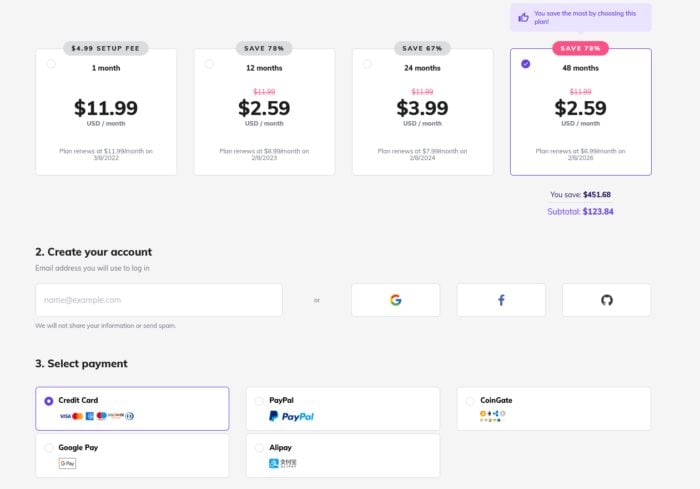
Conveniently, that checkout page is all set up with my recommendation. You’ll get premium shared hosting, which is the lowest-cost plan that also includes a free domain name.
My tip is to select the longest term for the best rate. If you commit to four years of hosting up front, you can lock in a really attractive rate of $2.59 per month.
Just click on the right-most box at the top to make sure you get the best deal.
Take a look at the add-ons below there to see if any are useful to you. None of them are absolutely necessary, but daily backups and priority support are helpful features, and they’re reasonably priced.
After that, enter your payment information, click Submit Secure Payment, and then you’ll be onto setup.
Step 2: Select Your Hosting Type
With my offer for Hostinger’s shared hosting, you actually don’t have to select a hosting type yourself. Premium shared hosting is all ready to go for you.
However, you may know enough about your website’s needs to also know that you might need a more powerful hosting type than shared hosting, like VPS or dedicated.
If you have no idea, read on to learn a little bit about the differences between those three types of hosting and who each one is best for.
Shared Hosting
I would recommend shared hosting if you’re starting a new website.
Not only are the plans under this category cheap, but they can also accommodate the needs of low-traffic sites quite efficiently. Your website is hosted on a server along with a bunch of other websites. You save money by sharing server resources with the other tenants.
It’s like living in an apartment versus having your own house. It costs less and you don’t have to worry about maintenance.
If one of the sites on the shared server starts taking too many resources, it can cause problems for your site’s performance. This is why shared hosting isn’t appropriate for really big complex websites.
If you’re just starting out with your website or revamping a small business or local site, you probably don’t have to worry about this. Shared hosting is perfect for someone who doesn’t expect high traffic volumes and lacks technical knowledge. Around 40% of businesses get less than 10,000 unique monthly visitors on websites, and shared hosting is fine for this number.
If you’re building a website for a small or local business and concentrating on driving quality traffic that is likely to convert — and not building something like a viral media site — starting with shared hosting is likely optimal. You can always switch to a different model later if you find your site growing beyond what the shared servers can handle.
Cloud Hosting
Cloud hosting allows you to get better performance without having to pay the significantly higher price tags for the options that come after this one.
With cloud hosting, you get the same environment as shared hosting (that is, you’re sharing resources with the other sites on servers), but multiple servers work together via the cloud to prevent any one from getting bogged down because of a bulky, popular, or resource-hungry site.
That usually results in more reliable speed and uptime, since you’re not sharing the resources of just one server. This might be a good option if you’re not expecting extraordinary traffic on a regular basis but it’s critical for your business model that you maintain uptimes and speeds no matter what any other site sharing your resources does.
Cloud hosting is a good half-step up from shared hosting but not as powerful and reliable as the next option.
VPS Hosting
VPS hosting stands for virtual private server hosting. This category includes plans for websites that want better performance and can accommodate a higher price point.
The good thing about this hosting type is that it guarantees useful resources for you exclusively. Technically, you still share a server with other websites, but you have a “virtual“ server that includes dedicated resources.
You can consider this hosting type if you expect sudden spikes in traffic volumes.
Dedicated Hosting
Dedicated hosting gives you exclusive access to an entire server reserved for your website alone. You don’t have to share it with anyone.
Understandably, you get premium performance with this subscription plan, but you have to be ready to pay its premium price, too.
This is a good option if your business is a large enterprise that regularly handles high traffic. It’s also great for those who want complete control over the hosting environment, such as businesses in more regulated industries like healthcare or finance.
For this guide, I’ll suggest you choose the premium shared hosting plan that’s preselected. However, if you prefer other plans, you can easily select them to customize how you set up your free domain name and pay for hosting to go along with it.
Step 3: Claim Your Free Domain Name
After you’ve completed checkout and payment, you’ll be taken to your Hostinger control panel, hPanel.
There, you’ll see an option front-and-center for claiming your free domain.
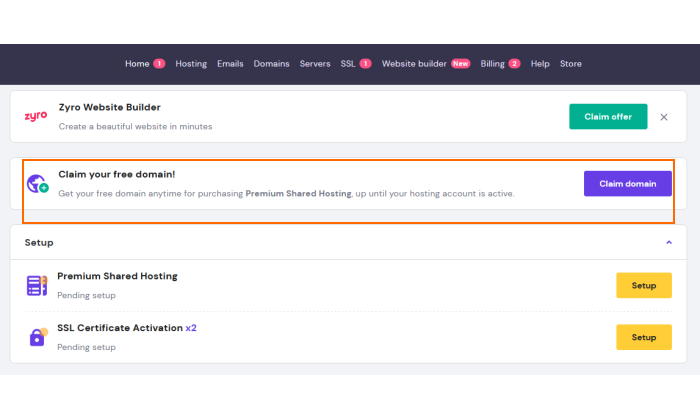
Click Claim Domain to search for your preferred free domain name. Once you see it, click the purple box next to it.
I’d encourage you to select a .com extension, as it looks more professional and helps you appear more reliable to your visitors.
The only time that I’d consider an alternative domain extension is if the .com extension is already taken and you are absolutely set on the name.
Having a .com domain is particularly important for businesses—small blogs, personal sites, and side hustles may be able to save a few bucks by going for an alternative extension.
After that, you’ll just have to enter some basic information to register your free domain name. Fill out the form and submit it. Hostinger will take a few minutes to verify your registration information, and then send you an email with a link to complete the verification.
With that, you’re all set on securing your free domain name!
There’s just one more thing I recommend.
Make sure to enable WHOIS protection. After you’ve completed verification, you’ll be taken to the section of your dashboard for your new free domain name. Then, just look for the slider button under WHOIS Privacy and click it so it becomes purple and enabled.
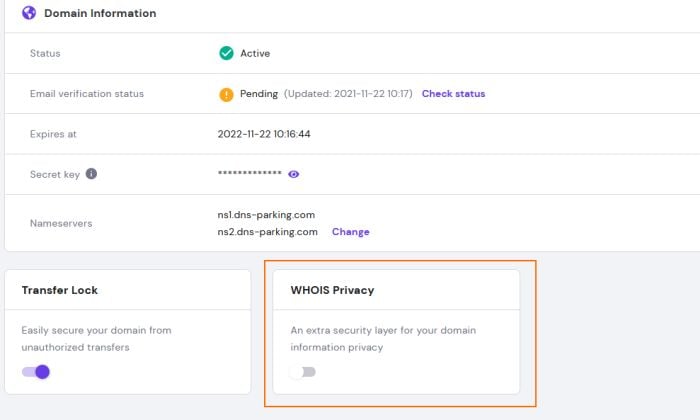
Doing this will conceal your name, email, phone number, and address from appearing on a public database, providing some important benefits including:
- Reducing spam: Spammers mine data anywhere they can get it, and having your name, email, and phone number in a public database can lead to an onslaught on your inbox or an increase in robocalls. No one has time for that.
- Decreasing risks of identity theft: Your personal name alongside phone numbers, emails, and addresses provides fodder for fraudsters, who may use that information to fuel identity theft efforts.
- Making your physical location harder to find: Not every blogger and small business owner wants their physical location, business address, or even home address on display for everyone to see. For example, if you run a small e-commerce drop-shipping business from your home office, you may not want the entire world to know where your family lives.
- Separating personal and business messaging: WHOIS privacy lets you create a separation between your personal name and your business brand. This can be important if you want to separate your personal life, views, or messaging from those associated with your business.
Once you complete that last step to safeguard personal privacy, you’re done!
You now have an excellent hosting plan as well as a free domain. If you have not already started, then start now at Hostinger.
Other Ways to Get a Free Domain Name
For the sake of comprehensiveness, I’ll also discuss two other ways of getting a free domain. Although I don’t recommend them, it’s always good to know all of the options.
- get a free subdomain
- use a free domain registrar (not recommended)
I’ll explain each of these methods in greater detail below, including the reasons why I don’t recommend them when talking about how to get a free domain.
Option 1: Get a Free Subdomain
Several website builders offer subdomains, which is a personal domain that exists within an existing domain name.
Remember that movie Inception where Leonardo DiCaprio dreams that he is in a dream? Something similar happens here.
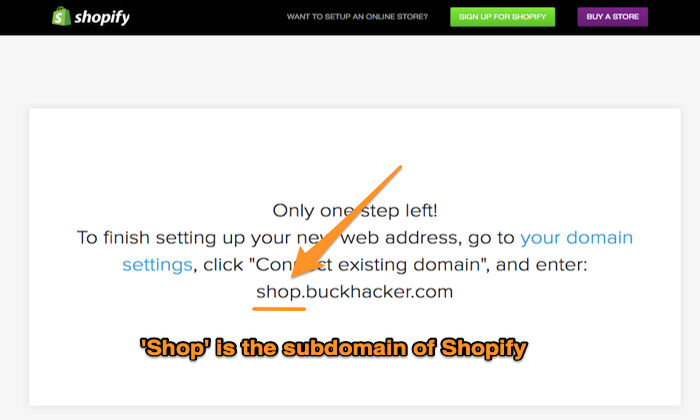
You end up getting a domain name within a domain name.
Site builders like Wix, Squarespace, and Weebly offer subdomains to their users. They have a free trial as well, so if you like their services, you can purchase their premium plans that include everything you require to build, launch, and manage a professional business website.
You typically get a free domain name with these options along with a few other perks, including:
- Drag-and-drop site builder: Many of these sites make it easy to build a basic site with drag-and-drop widgets. This means you don’t need to know any code to create a site that looks professional.
- Web hosting: The package you pay for includes web hosting, which means you get a convenient all-in-one box for creating a basic website.
- Templates: Many of these sites let you start with templates, so you’re not building a site from scratch. You simply choose the template that best matches your needs and customize it from there, but customization options may be limited.
- Search engine optimization (SEO) tools: These site builders often provide some basic SEO tools to help you optimize content with keywords and metadata.
Given those perks, why do I still say this method is not ideal?
First, some of those perks can be a bit limiting, especially if you want to grow outside of the box with your website. You also run into all the challenges of not having a clean .com I discussed earlier in this article.
Let’s dig deeper into those issues with an example.
Imagine you use a free website builder like Wix. You won’t have to pay for a domain, yes, but your site will have the Wix subdomain. It’ll look something like this:
yourusername.wixsite.com/yoursiteaddress
Suppose your Wix username is “My Stunning Website 123,” and the free domain name you want is myblogsite. Here’s what you’ll get:
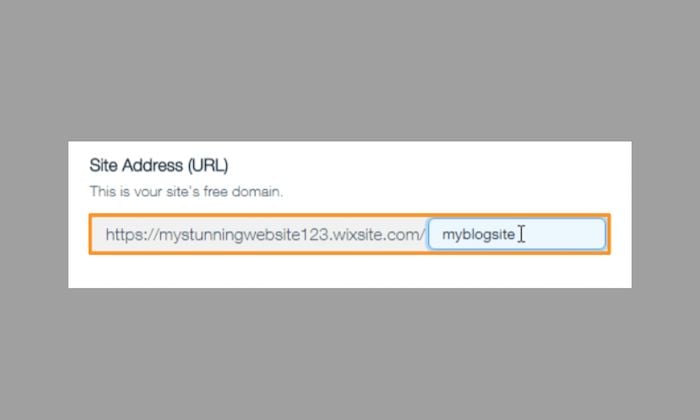
Think about it: Does that look professional? Have you seen any credible websites that have domains like this? Would you input your personal information or credit card data into a site with this type of URL structure and feel good about it? If not, why would you expect customers to do the same.
That is why I’d only suggest this method if you want to experiment with your website builder’s free features or new updates.
WordPress is your other option, and luckily, it is not as invasive as Wix. The format for a free WordPress subdomain is: yourdomainname.wordpress.com
This is a good option for situations when one cannot spend money, but it is not a viable long-term strategy. You want your free domain name to be memorable and short—both of which aren’t possible when you use a subdomain.
The fact that your visitors won’t remember your domain or find it hard to remember is another disadvantage. Even if these site builders offer some SEO tools to help you give your site a slight boost in the search engine results, that positive might wash out to a neutral, at best, if people can’t remember your domain.
Option 2: Use a Free Domain Name Registrar (Not Recommended)
You can get a free domain name from a free domain registrar, but it’s generally unsuitable. Especially if you want your domain to reflect a certain level of professionalism or trustworthiness.
You see, the truly free domains use uncommon extensions. For instance, you’ll get .tk instead of .com.
Your prospective customers would much prefer working with a domain name that reads yourbusiness.com instead of your yourbusiness.tk. Uncommon extensions are confusing for many people, and they can quickly erode trust. At a time when many people are aware of online phishing and scam schemes but don’t fully understand them, having a site show up with an unfamiliar extension creates too many questions in the consumer’s mind.
Add to that the fact that it’s much easier to remember a .com than some domain extension few people have seen before, and you can see why this isn’t a great option.
Plus, you don’t own the domain name, which also defeats the purpose of launching a blog or a website.
However, if you do decide to take this route, you can check out Freenom and GetFreeDomain.Name.
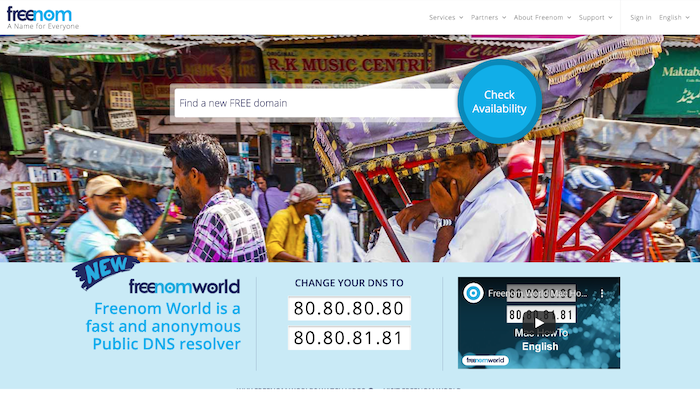
Several domain registrars will give you a free domain in exchange for running ads on your website. There is nothing wrong with running ads, but this just isn’t the best way to do it. Here’s why:
- Lack of control over ad content: You don’t have full control over what ads play. The network might promote ads you don’t agree with or that turn off your target audience. This can lead to people clicking away from your site without ever reading your content or considering your goods or services.
- Lack of control over ad placement: You might not have control over where ads are placed. That could mean ads take the prime spots where you’d really like your CTAs to go. It can also mean a site that doesn’t look visually appealing or even one that looks spammy. That drives down customer experience, which usually drives up bounce rates.
- Loss of potential ad revenue: Suppose you’re successful in driving high traffic to your website and the ads get one million views. You won’t receive a single penny from those ads–all you get is a free domain. That’s certainly not a fair trade, and financially, you would have been better off paying for the domain name.
- Loss of potential conversions to add clicks: On the other hand, you may want to avoid clicks on ads altogether. Ad clicks that you earn money from are great if you’re monetizing a blog or other type of site. However, if you’re setting up an e-commerce site, you don’t want people clicking on ads. You want them to click on your buy buttons, and ads can take away from that.
- Potential damage to SEO ranking: The poor customer experience that inappropriate, too many, or poorly placed ads creates leads to poor behavioral metrics on your website. That means people click away from the site before they engage. They don’t click on other pages on your site, and they don’t spend time with your content. Those metrics can damage your SEO performance and ranking, as Google does consider behavioral metrics when ranking pages.
If you’re seriously toying with the idea of running ads on your website, I’d advise you to do so through a legitimate advertising network as it can be a great source of income. Don’t exchange ads for a free domain.
Important: Don’t Forget to Renew Your Domain Name!
Pay attention to how long the term is for your initial domain purchase. I cannot stress this enough.
Setting up a website or blog is hard work. You put in a lot of effort to find the perfect URL, design a website, and publish relevant content on it.
So, just imagine the horror when you get up and realize some random stranger has bought your domain out from under you.
The reason? You forgot to renew your domain.
Tragic.
Many people have made this mistake in the past, and it cost them dearly.
Here’s just one example of the shenanigans that can occur when domains expire: In July 2021, Vidme, a video embedding platform, failed to renew and caused expired embeds. That means that videos embedded in content on sites ranging from the Washington Post to New York Magazine were “naked.”
An adult website scooped up the Vidme expired domain, an action that eventually led to adult video content showing up as the embedded videos on older news stories and on other web pages. It was a huge fail for Vidme, but also a major issue for the brands and trustworthiness of all sites with those embedded videos.
How can you avoid this?
First, take note of your initial term. A lot of registrars default to a one-year registration, but with some, you can buy five, 10, 20, or even 100 years at checkout.
The longer your initial term, the longer you don’t have to fret about renewal. Plus, you lock in the annual rate for the duration. That can save you money over the long term because like all other goods and services, domain name prices can increase over time.
Second, and this is most important if you don’t buy a multi-year term at first, is to make sure the domain renewal date is marked on your calendar with a reminder set for around one month in advance.
That way, you can prepare for renewal without your registration lapsing.
A one-month heads-up also gives you a chance to review the renewal rates from your domain registrar. Sometimes, that renewal rate jumps up quite a bit. If it’s more than you were expecting, at least you have a few weeks to consider your budget and options.
Last, if you don’t have a shoestring budget, I’d suggest just setting your domain to auto-renew.
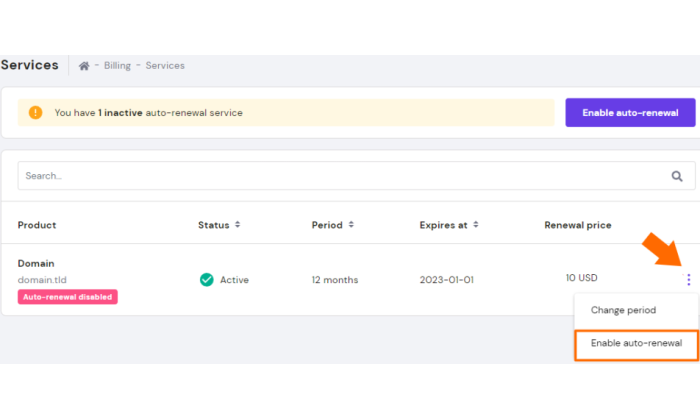
With most providers, you can find in your dashboard the expiry date of your domain, the renewal cost, and an option to enable auto-renewal. You can see in the image above that Hostinger makes this really easy in its services submenu under billing settings.
The other providers I’ve reviewed on this list also allow for auto-renewal, so you can set it and forget it with any that you choose.
I just suggest checking in on your domain’s renewal rate before the time comes, so you don’t get any unfortunate budgetary surprises if the rate spikes on you.
You also do need to ensure you use a payment method that won’t expire before the renewal date.
Most sites won’t automatically drop your domain name if the payment method has expired. Typically, you’ll receive an email letting you know the payment expired and you have a certain amount of time to update it.
However, emails can get lost in the shuffle, and this is just another way you could accidentally lose your domain name. Use a credit card or other payment methods with expiration dates a few years out if you can to avoid this issue.
FAQs
Can I get a domain for free?
Yes, if you’re looking for how to get a free domain, it’s as easy as signing up with Hostinger or another provider that offers free domain names. Note that a free domain doesn’t mean you automatically have a website. You still need to set up hosting.
Which free domain is best?
I recommend Hostinger. It’s easy to set up and offers free domain names with common extensions such as .com. You can purchase hosting through Hostinger for less than $3 a month, making it an affordable solution for getting a free domain and adding the hosting necessary to get your site up and running online.
How do I auto-renew my domain?
To auto-renew your domain and ensure you don’t accidentally lose it to someone else, simply select auto-renewal settings with your domain provider. You can usually find the expiry date for the site in the dashboard or settings. Look for a box or other option you can toggle on to select auto-renewal. Just be sure that the payment method you enter will work when the auto-renewal date arrives.
Conclusion
Hostinger is the best way to get a free domain name–one that you won’t have to surrender even if you switch web hosts.
The other way is to use a subdomain by using reliable and reputable web builders like WordPress and Wix.
Within seconds you’ll have a reliable web hosting service as well as a new free domain name. Trust me, saving a few dollars isn’t worth the hassle of looking unprofessional, running a spammy website, or getting hacked.

